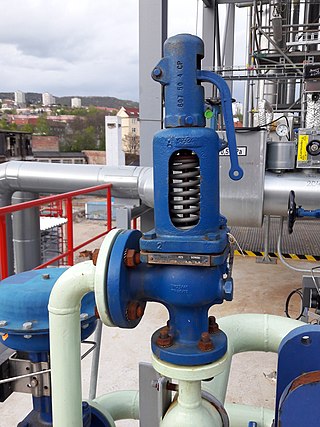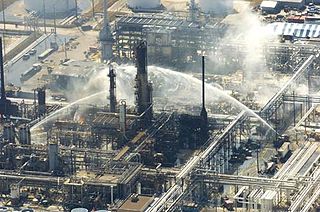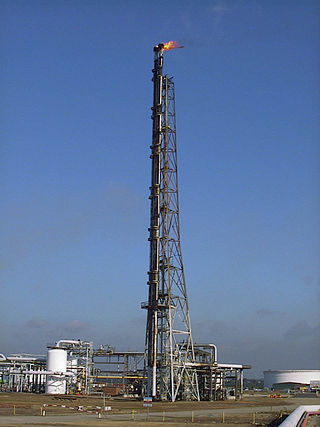Emergency depressurization (EDP)
Emergency depressurization, or blowdown, is an important system for safeguarding process plant in the event of an emergency. Equipment such as pressure vessels exposed to fire could undergo catastrophic failure leading to an uncontrolled loss of containment. Depressurization reduces potential failure by removing inventory from the plant thereby decreasing the internal mechanical stresses and extending the plant’s integrity at elevated temperatures. [4]
As described above a process plant is typically divided into isolatable sections by emergency shutdown valves (ESDVs). Each section may be designated as belonging to a fire zone that is depressurized by a dedicated blowdown (depressurization) valve (BDV). During ESD conditions, the depressurization of only specific isolatable sections is undertaken. However, during more widespread emergency circumstances, the whole facility may be depressurized. [4]
In a typical depressurization system, the goal is to reduce the pressure in the plant to less than 50% of the design pressure within 15 minutes, or to reduce the internal pressure to 7 barg from the design pressure in 15 minutes. [4]
In certain circumstances, flare systems may not have the capacity to handle the entire plant's depressurization load. The blowdown of certain plant may be delayed until after the peak of the depressurization flow has passed.
A depressurization system comprises an actuated valve and a restriction orifice. The BDV valve is normally held in the closed position but opens on demand or on failure of the actuator. An orifice (RO) downstream of the BDV is sized to achieve the blowdown rate described above. A locked open valve may be located downstream of the orifice. The valve, in the closed position, allows the functionality of the BDV to be tested without depressurizing that section of the plant. [5]

Safety engineering is an engineering discipline which assures that engineered systems provide acceptable levels of safety. It is strongly related to industrial engineering/systems engineering, and the subset system safety engineering. Safety engineering assures that a life-critical system behaves as needed, even when components fail.

A nuclear meltdown is a severe nuclear reactor accident that results in core damage from overheating. The term nuclear meltdown is not officially defined by the International Atomic Energy Agency or by the United States Nuclear Regulatory Commission. It has been defined to mean the accidental melting of the core of a nuclear reactor, however, and is in common usage a reference to the core's either complete or partial collapse.

A boiler is a closed vessel in which fluid is heated. The fluid does not necessarily boil. The heated or vaporized fluid exits the boiler for use in various processes or heating applications, including water heating, central heating, boiler-based power generation, cooking, and sanitation.

A fire sprinkler system is an active fire protection method, consisting of a water supply system providing adequate pressure and flowrate to a water distribution piping system, to which fire sprinklers are connected. Although initially used only in factories and large commercial buildings, systems for homes and small buildings are now available at a cost-effective price.

A safety-critical system or life-critical system is a system whose failure or malfunction may result in one of the following outcomes:

A relief valve or pressure relief valve (PRV) is a type of safety valve used to control or limit the pressure in a system; excessive pressure might otherwise build up and create a process upset, instrument or equipment failure, explosion, or fire.

A fire sprinkler or sprinkler head is the component of a fire sprinkler system that discharges water when the effects of a fire have been detected, such as when a predetermined temperature has been exceeded. Fire sprinklers are extensively used worldwide, with over 40 million sprinkler heads fitted each year. In buildings protected by properly designed and maintained fire sprinklers, over 99% of fires were controlled by fire sprinklers alone.

The Texas City Refinery explosion occurred on March 23, 2005, when a vapor cloud of natural gas and petroleum ignited and violently exploded at the isomerization (ISOM) process unit at the BP Texas City refinery in Texas City, Texas, killing 15 workers, injuring 180 others and severely damaging the refinery. The Texas City Refinery was the second-largest oil refinery in the state, and the third-largest in the United States with an input capacity of 437,000 barrels (69,500 m3) per day as of January 1, 2000. BP acquired the Texas City refinery as part of its merger with Amoco in 1999.

A gas flare, alternatively known as a flare stack,flare boom, ground flare, or flare pit is a gas combustion device used in places such as petroleum refineries, chemical plants and natural gas processing plants, oil or gas extraction sites having oil wells, gas wells, offshore oil and gas rigs and landfills.
In functional safety a safety instrumented system (SIS) is an engineered set of hardware and software controls which provides a protection layer that shuts down a chemical, nuclear, electrical, or mechanical system, or part of it, if a hazardous condition is detected.
A blowdown stack is an elevated vent or vertical stack that is used to vent the pressure of components of a chemical, refinery or other plant if there is a process problem or emergency. A blowdown stack can be used to complement a flare stack or as an alternative. The purpose is to prevent 'loss of containment' of volatile liquids and gases. Blowdown from several systems may be combined in a blowdown header prior to the stack. A knock-out pot may be provided at the base of the stack to remove any liquids. Blowdown stacks may either be ignited or un-ignited. The height of the blowdown stack must be tall enough to ensure the safe dispersal of vapour.
A shutdown valve is an actuated valve designed to stop the flow of a hazardous fluid upon the detection of a dangerous event. This provides protection against possible harm to people, equipment or the environment. Shutdown valves form part of a safety instrumented system. The process of providing automated safety protection upon the detection of a hazardous event is called functional safety.
A high-integrity pressure protection system (HIPPS) is a type of safety instrumented system (SIS) designed to prevent over-pressurization of a plant, such as a chemical plant or oil refinery. The HIPPS will shut off the source of the high pressure before the design pressure of the system is exceeded, thus preventing loss of containment through rupture (explosion) of a line or vessel. Therefore, a HIPPS is considered as a barrier between a high-pressure and a low-pressure section of an installation.
Spurious trip level (STL) is defined as a discrete level for specifying the spurious trip requirements of safety functions to be allocated to safety systems. An STL of 1 means that this safety function has the highest level of spurious trips. The higher the STL level the lower the number of spurious trips caused by the safety system. There is no limit to the number of spurious trip levels.
The three primary objectives of nuclear reactor safety systems as defined by the U.S. Nuclear Regulatory Commission are to shut down the reactor, maintain it in a shutdown condition and prevent the release of radioactive material.

Instrumentation is used to monitor and control the process plant in the oil, gas and petrochemical industries. Instrumentation ensures that the plant operates within defined parameters to produce materials of consistent quality and within the required specifications. It also ensures that the plant is operated safely and acts to correct out of tolerance operation and to automatically shut down the plant to prevent hazardous conditions from occurring. Instrumentation comprises sensor elements, signal transmitters, controllers, indicators and alarms, actuated valves, logic circuits and operator interfaces.
Partial stroke testing is a technique used in a control system to allow the user to test a percentage of the possible failure modes of a shut down valve without the need to physically close the valve. PST is used to assist in determining that the safety function will operate on demand. PST is most often used on high integrity emergency shutdown valves (ESDVs) in applications where closing the valve will have a high cost burden yet proving the integrity of the valve is essential to maintaining a safe facility. In addition to ESDVs PST is also used on high integrity pressure protection systems or HIPPS. Partial stroke testing is not a replacement for the need to fully stroke valves as proof testing is still a mandatory requirement.
Boiling water reactor safety systems are nuclear safety systems constructed within boiling water reactors in order to prevent or mitigate environmental and health hazards in the event of accident or natural disaster.
Lean air is a gas mixture with an oxygen content lower than 20.95%. Lean air is made from a gas mixture of air with nitrogen or of pure oxygen with nitrogen and is used in several production processes where a product covering with pure nitrogen can be dangerous, undesirable or more expensive. In some production processes the oxygen content is necessary for the reaction process or during storage.

A domino effect accident is an accident in which a primary undesired event sequentially or simultaneously triggers one or more secondary undesired events in nearby equipment or facilities, leading to secondary accidents more severe than the primary event. Thus, a domino effect accident is actually a chain of multiple events, which can be likened to a falling row of dominoes. The term knock-on accident is also used.










